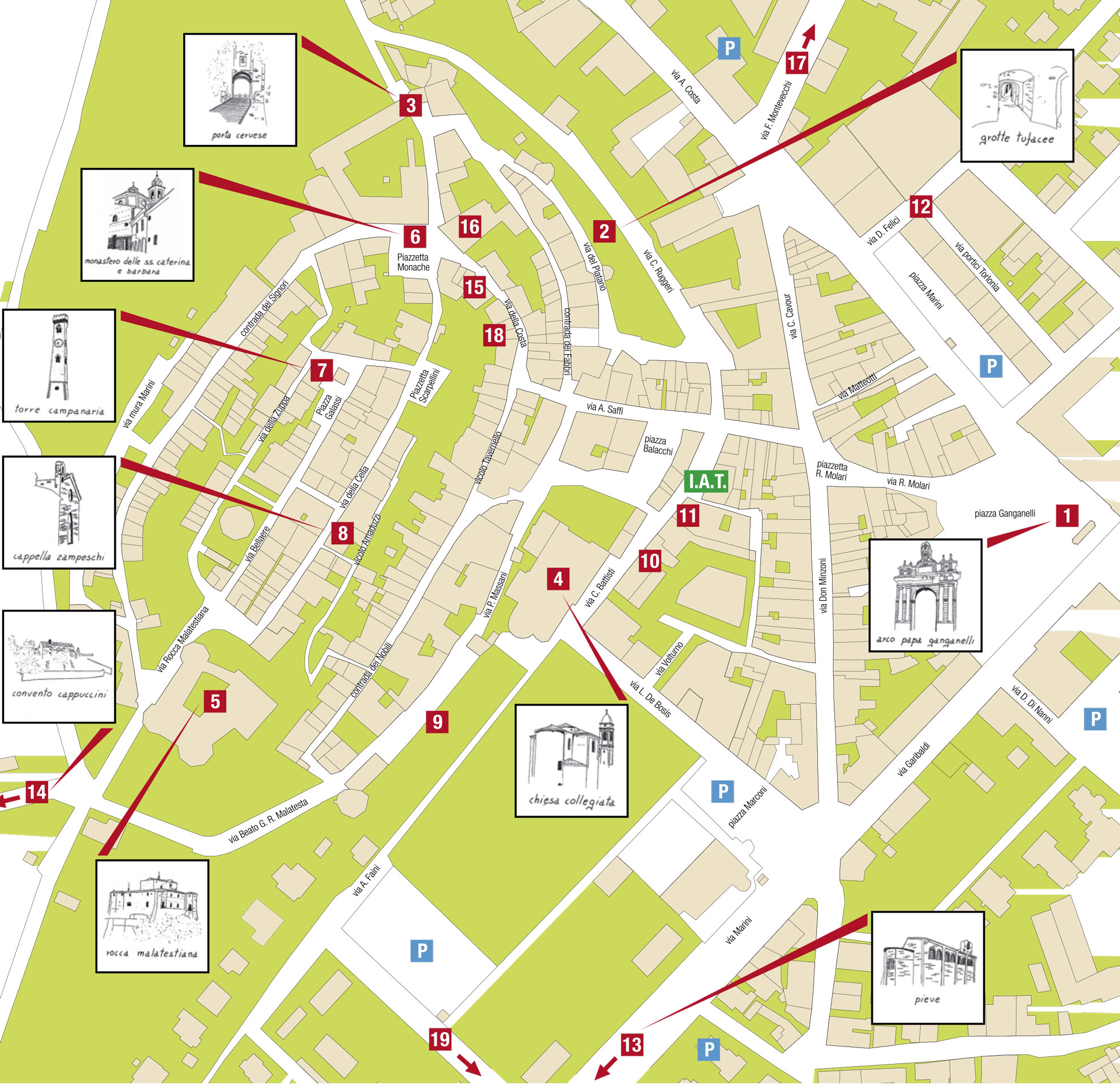City Guide
Santarcangelo di Romagna is a medieval town that boasts ancient origins. Certainly, much is owed to its geographical location, easily reached from many directions; its numerous fairs throughout the year attracting thousands of people to the town since immemorial times; and its many attractions such as: the Ganganelli Arch, erected in honour of fellow citizen, Pope Clement XIV, and the square with the same name, the imposing Malatestian Fortress, the Collegiate Church, the Bell Tower, the ancient Mangano, the ancient town gates (Porta Cervese and Porta del Campanone Vecchio), its museums and the mysterious Grottoes (Caves). A true underground labyrinth beneath the entire historic centre.
Saint Michael’s Fair in September and Saint Martin’s Fair in November are still the most important fairs regionally.
All year round, Santarcangelo has many thematic fairs, such as the springtime fair, Balconi Fioriti (Flowered Balconies) in May, dedicated to the world of nature; Calici Santarcangelo in August, dedicated to the appreciation of wine; Casa del Tempo, a monthly antiques market; Not Film Fest at the end of August, an independent film festival; and Cantiere poetico in early September, an initiative aimed at deepening and renewing the relationship between the community of Santarcangelo and its poetic identity.
The most important cultural event of the year is the International Festival of Theatre held in the main Square in July. This is an internationally renowned avant-garde festival offering a glimpse of contemporary theatre.
Find out about all Santarcangelo has to offer, including accommodation, dining, as well as lots of historical information, trivia and promotional videos: https://www.santarcangelodiromagna.info/

Place of Interest
Arco Ganganelli (1)
One of the most amazing and little known facts of our town is that in 1769 Cardinal Lorenzo Ganganelli from Santarcangelo di Romagna was elected Pope. The Roman Curia, through it’s representative Cardinal Legate, made the people of Santarcangelo understand that this important historical event deserved a significant celebration. The task was given to Cosimo Morelli from Imola, the Holy See’s “officiai” architect, who decided to create a beautiful triumphal arch at the side of the homonymous square Ganganelli apace with the former Via Emilia. lt was completed in 1777.
Santarcangelo's Caves (2)
The medieval town of Santarcangelo is built on a mysterious underground city, a hidden world made of shafts, tunnels and grand circular halls:
in the eastern part of the hill on which the town stands (“Colle Giove”) you’II find
166 caves.
For tours and more information: 0039 0541624270
Cervese Gate (3)
The gate is named after the ancient Roman road that connected Santarcangelo to the Salt pans of Cervia. Cervese Gate is one of the tour entrances to the medieval town and is the only one stili standing today.
lt dates back to the 14th century when Carlo Malatesta rebuilt the town walls, that were later fortified by his grandson Sigismondo Pandolfo in 1447.
For tours and more information: 0039 0541624270
Chiesa Collegiata (4)
The Church’s construction began in 1744 and was completed 12 years later. In arder to make the church services more suggestive in 1779 one of the most prestigious organ builder, Gaetano Callido from Venice, was commissioned to build a splendid organ, which is stili functioning perfectly today. The Church houses the work of art by Guido Cagnacci, entitled ” San Giuseppe, S. Eligio e Gesù Bambino”. The painting was requested by the Brotherhood of Carpenters and Blacksmiths and depicts the patron saints of both crafts. The piece is signed and dated 1635, it is also the first painting that can by attributed to Cagnacci with any certainty. Furthermore, the Church hosts a crucifix from Rimini’s School of Giotto from the 12th century, coming from the ancient Pieve. On the far left side of the building you’II find a chapel, emplaced in 1821, that preserves the rei ics of the Blessed Simone Balacchi.
Rocca Malatestiana (5)
Built on ancient ruins, the current stronghold consists of a keep dating back to 1386 and a structure with three polygonal fortified towers. lt was erected by Sigismondo Pandolfo Malatesta in 1447, as the inscription beside the main entrance tells us. lnside you’ll find a beautiful courtyard with a medieval cistern and three salons, large rooms which preserve 17th century ecclesiasticals furniture from the sacristy of San Romualdo of Classe di Ravenna. lt is thought that the tragedy of the famous Francesca from Rimini may have happened in one of the rooms of the first fortress.
Piazza delle Monache (6)
This is one of the most charming squares of the old town. lt is overlooked by the Monastery of San Caterina and Barbara (XVI century) with its adjoining church
(1738) and Palazzo Cenci (XVII-XVIII century), now home of the town’s Museum of History and Archaeology.
Torre campanaria (7)
Today the bell tower, known by the locals as “Campanone”, is 25 meters tall and is located in Piazzetta Galassi. lt was built in Neo-Gothic style in 1893 to replace the old tower considered to be derelict. The tower is an iconic feature of the town’s skyline and, together with the “Arco Ganganelli”, is considered one of the most symbolic structures in the town.
Celletta Zampeschi (8)
1530-1534 (now “Chiesa della Cella”) The chapel was built for Antonello di Brunoro Zampeschi during his four years administration, after he requested a piace for his private worship and devotions.
After World War Il only the facade remains intact. Today it houses the locai
“Workers Society for Mutuai Aid” who curate important archival collections from the ltalian Risorgimento.
Sferisterio (9)
“Tamburello” are stili played today by the locals.
Pescheria (10)
The locai fish market was opened in 1834 and “since then has remained in its original location. The building stili has the originai wrought iron gates and the stone benches from S. Marino.
Stamperia Marchi (11)
Portici Torlonia (12)
1861 (Open Gallery of Piazza della Canapa – current Piazza Marini, known as Piazza delle Erbe) This open gallery was originally conceived as in early 19th century “shopping center” and commissioned by a locai farming business “Villa Torlonia” from San Mauro Pascoli, who’s owner was the famous Giovanni Pascolis’ father. The fruit and vegetable market is stili held here every Friday morning.
Pieve (13)
Convento Cappuccini (14)
The “Cappuccini” Monastery (1654-1661) was re-occupied in 1852 following a suspension ordered by the Napoleonic government. lt stands at the top of “Colle Giove”, which is also where, according to the legend, the locai Sangiovese wine originated from. A charming terrace offers a spectacular view that stretches from the town center to the sea. Nearby you’II find the designated city park.
MUSEI
Nel mondo di Tonino Guerra - The World Of Tonino Guerra (15)
The museum is located in the former “Monte Pietà” built around 1630 and houses the works of this fine artist. On display there are over than 60 pieces of art that include paintings, sculptures, ceramics, tapestries and printed cloths that testify his talented and prolific work.
The Museum is currently closed.
